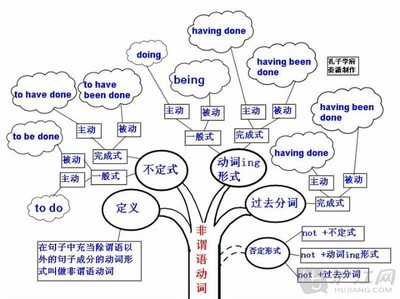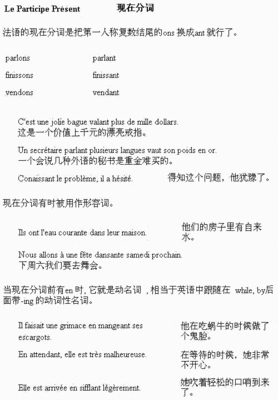非谓语动词,顾名思义,即不能作句子的谓语用的动词,也称动词的非限定形式。主要分为动词不定式,现在分词,过去分词和动名词四种,非谓语动词也有动词的特征,可有自己的状语和宾语。
二、动词不定式(The Infinitive)
动词不定式是动词的一种非限定形式,有加“to”和省to两种形式,可以在句中作主语、表语、定语、宾语,宾语补足语、状语等成份。
1、动词不定式作主语。
To get an Injectionis a little painful.
To complain too muchisn’t a good thing.
注:(1)不定式作主语,整个结构看成一个整体,谓语用单数形式,还可用it作形式主语而把不定式放于句末,保持句子平衡。如
It takes me two hoursto finish my English homework.
It’s difficultto Learn English Well.
(2)不定式作主语有两种特殊结构,一般认为是由for 或of引导其逻辑主语,如
It’s importantfor us learn a foreign language.
It’s difficultfor us to finish it on time.
It’s kind /good/niceof you to help me.
It’s clever /foolish/polite/careful/carelessof you to do that.
2、动词不定式作表语。
My job isto feed animals.
Our duty isto keep the classroom clean and tidy.
His wish isto become a singer.
3、动词不定式作宾语
He wantsto borrow a book from me.
I hopeto see my pen friend as soon as possible.
Children loveto play games.
I found it difficultto get on with him.(it为形式宾语,真正宾语为不定式)
注:不定式有时与疑问句where, how, what, which, when, who 等连用,作动词的宾语。
如:What to do
I don’t know How to do it
Where to go
When to set off
Which one to choose
Who to ask
He gave a talk onhow to study English Well.
4、不定式作定语
Would you like somethingto drink /to read/to eat?
I have a lot of homeworkto do.
I have something importantto tell you.
5、不定式作宾语补足语。分省“to”和加“to”两种。
I told himto do it himself.(加to)
He asked meto buy some oranges for him.(加to)
We didn’t expect himto be the winner.(加to)
I often saw himgo to the cinema last year.(省to)
Please let the boycome in.(省to)
The boss makes the workerswork ten hours a day.(省to)
注:感观动词(see, watch, notice, hear, feel)和使役动词(have, let , make)后用省to不定式作宾补,但改成被动语态时,不定式前加to,宾语补语相应变成主语补语。
如;The workers are madeto work ten hours a day.
6、作状语
They went to the shopto buy some school things.(目的状语)
My sister to youngto go to school.(结果状语)

三、现在分词(The Present Participle)和过去分词(The Past Participle)
现在分词由动词加“ing”构成(构成方式略)表示主动或正在进行;过去分词由规则动词加“ed”或查不规则动词表,一般表示被动或动作已完成。分词主要起形容词和副词作用,可在句中作表语定语,状语、宾补等成份。
1、作表语
The news isexciting.
The result isamazing
The window isbroken.
The door islocked.
2、作定语
Do you know the young manstanding under the tree?
The womanwearing a red coatis my aunt.
I like to read bookswritten by LuXun.
She asked Grandma to put a bookmark in each of theborrowedbooks.
Then we can see many dinosaursdiscovered by youin the museums.
3、作状语
A lot of land has gone with the trees,leaving only sand.(结果)
They wake up their parents ,calling “Merry Christmas”(伴随)
Given more time,I can finish the work myself.(条件)
4、作宾补
I hear a girlsinging in the next room.
I’ll have my haircuttomorrow.
We had our picturestaken in the middle of the square.
四、动名词(The Gerund)
在形式上,动名词与现在分词无法区别,但现在分词里一个动词性的形容词,而动名词则是一个动词性的名词,它具有名词的绝大多数特征,可作主语、宾语、表语、定语、宾补等成份。
1、作主语
Seeingis believing.(眼见为实)
Selling computers to foreign countriesis his job.
Picking applesis much better than having classes.
注:动名词作主语可与表语对调位置;有时也可用it作形式主语,而将动名词放于句末。如:
His job is selling computers to foreign countries.(主语与表语可互换)
It’s no usecomplaining about others.
2、作表语
His job isfeeding animals.
The only thing that I want to do issleeping.
3、作宾语,分为动词宾语与介词宾语两种。
Tom enjoysliving in Beijing.
Have you finishedreading that novel?
Would you mindmy opening the door.
I often practicespeaking English with foreigners.
Thank you forteaching us so well.
What aboutgoing fishing tomorrow?
注:有些动词后加不定式和动名词作宾语有两种截然不同的含义。
如:go on to do sth.(接着做另一件事)
go on doing sth.(继续做同一件事)
forget /remember to do sth.(记住或忘记去做某事,还未做)
forget /remember doing sth.(记住或忘记做过某事,事先已做过)
stop to do sth.(停下来做某事)
stop doing sth.(停止做某事)
4、作定语
a swimming pool 游泳池a sleeping car 卧铺车厢
a reading room阅览室a walking stick 手杖
注:现在分词作定语与动名词作定语的不同之处在于:现在分词相当于一个定语从句的作用,可改成定语从句,而动名词相当于一个名词作定语,说明被修饰词的类别、功能或性质,不可以改成定语从句。
Thesleepingchild=the childwho is sleeping
The womantalking with my fatheris my English teacher.
=The womanwho is talking with my fatheris my English teacher.
附录2:简单又快捷熟记非谓语动词
动词使用原形:
1. Will / Would you please + ( not ) + V(原)….?
2.Why not +V(原)….? = Why don’t you + V(原)
3. had better ( not ) +V(原)
加动词不定式省to:
使役动词或感官动词后加动词不定式省to:
1. let / make / have sb. do…让/使某人做…2. watch/see / hear / notice / feelsb. do …..
注意:在主动语态中省to的不定式在被动语态中要加to
对比:
1.hear / see sb. do…听见 / 看见…做了…
hear / see sb. doing…. 听见 / 看见…正做…
used to do…过去常常做… ,
不是被动语态,而是固定短语
2.be / get/ become used to doing …习惯于做…
被动语态
be used for doing… 被用于做….
be used to do …..被用于做….
动词后面加不定式:
tell sb.(not ) to do…告诉某人(不)做…
ask sb.( not ) to do…叫某人(不) 做…
want to do ..= would like to do … 想做….
3.want sb. to do.. = would like sb to do.. 想要某人做.. .
4.plan to do .. 计划做…
5. begin to do…, start to do…, start packing
6.try to do.. 努力/尽力做… try to learn English well
7. childrenloveto playthis game8. call to do …打电话做…
9. hope to do… ,hope( that) +句子10. be sorry to do…很抱歉做…
11. encourage sb. to do … 鼓励某人做 ….12. help (sb) (to) do…
13. get sb. to do….使某人做某事…14. learn to do….学做….
15. teach sb. to do…. 教某人做…16. decide to do …. 决定做….
17. wish sb. to do ….希望/愿某人做某事18. allow sb. to do…允许某人做….
19. warn sb. not to do… 警告某人不要做… 20. deserve to do.. 注定做…
21. (can’t) afford to do… (不能)负担得起做…22.can’t wait to do…迫不及待做..
23. seem to do …似乎要做…24. be to do … 将要做…
25. refuse to do….拒绝做…..26. agree to do…..同意做…..
27. expect to do….期望做…. 28. expect sb. to do ….期望某人做……
29. set one’s mind to do…. 一心想做某事
30. make up one’s mind to do….下定决心做某事
31. preferto do…… rather thando…..宁愿做…而不做…
32. It takes sb. some time to do sth. 花某人多长时间做某事
33. It’s + adj. + (for sb. ) to do …..(对于某人)做某事adj.
34. sb. finds it … to do…..某人发现做某事…..
35. It’s better / best ( for sb.) to do… 较好/最好做….
接动名词:
1. enjoy doing…, enjoy oneself2. finish doing…
3. hate doing… 讨厌做….
4. be good at sth. = do well in sth.
be good at doing …= do well in doing…..
5. what / how about doing…?6. thank sb. for doing….感谢某人做….
7. have fun doing…做…有乐趣8. have problems / difficult doing…做……有困难/问题
9. give up doing….放弃做…10. take part in doing….(积极)参加做….
11. make a contribution to doing….
12. practise doing…13. be worth doing… 值得做…
14. feel like doing…. 想要做….15. be interested in doing…
16. by doing… 通过,以….17. the way of doing….做….的方法
18. keep doing…一直做…19. keep sb. doing…让某人一直做…
keep on doing …反复做….
20. succeed in doing…成功做某事21. be busy doing….
22. spend ….(in) doing…. 花时间/钱做…
23. can’t help doing …. 禁不住 / 情不自禁做某事
24. instead of doing….. 代替做某事
25. prefer doing …. to doing…宁愿做…而不是做… ; 较喜欢做…而不是做….
20. keep / stop / prevent sb. from doing….. 阻止某人做某事
19. mind (sb. / one’s)doing …介意(某人)做….
既可加不定式,又可加动名词,但有区别:
like doing…表示一般情况
like to do..喜欢/愿意做…表示具体谋一次情况
2. remember to do…记得要做…3.forget to do…忘记要做…
remember doing…. 记得做过….forget doing….忘记做过…
4. stop to do…停下来做..(另一件事)stop doing…停止做…..
6. be afraid to do…不敢做…;害怕做…;be afraid of sth.害怕某物
be afraid of doing… 害怕做…
5. go on to do… 继续做另一件事go on doing…. 继续做同一件事
7. need to do….. 需要做…..need doing ……(某物/人) 需要被….
 爱华网
爱华网



